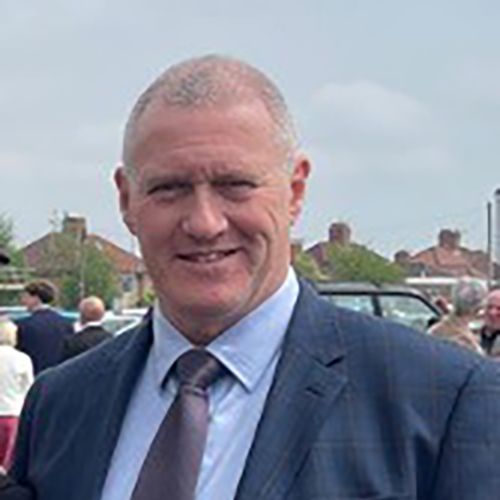
Stuart Jones
Former Senior Director of Global Sales Execution & Analytics
Mondelēz
Stuart has recently retired from Mondelēz International as Senior Director of Global Sales Execution & Analytics. His primary focus was the strategic development of a sales execution program that drives sales efficiency using integrated data. Previously, he was responsible for the deployment of sales automation solutions to more than 50 countries during a four-year period, working with a single provider to match a single process with adaptation for local business needs.
In his 38 years in FMCG, Stuart managed regional integrations and revenue management programs and held positions across all sales roles, including Category Management, Channel Marketing, and Senior Sales Leadership.

Hello Stuart! Congratulations on your recent retirement! You have a wealth of experience working in executive roles supporting the global sales efforts of Kraft Foods and Mondelēz International. What trends and challenges do you see as we exit the COVID-19 pandemic, but confront some of the macro-economic headwinds?


Thank you! It’s certainly weird not to be quite so busy. Although, I must admit there’s always something to do!
As the world exits the COVID-19 pandemic and withstands the impact of the war in Ukraine, we face an extremely cost-conscious market. While it’s difficult for manufacturers and producers to realize higher costs, retailers are trying to protect consumers, who have their own costs to manage.
Investments are cut, and the focus is then placed on short-term needs. Wise organizations realize that while short-term needs do require focus, they should not disrupt the balance of long-term needs. Markets will recover. Whilst consumers and buyers are more cost-conscious, manufacturers and producers must be nimble and react at pace. This will only happen if they have a balanced view.
This is where technology can be a leading factor. Today’s advancements can help organizations become more agile, remove repetitive tasks, and drive actions by using AI to analyze data and determine the best way forward.

The customer has been resilient, and recent industry revenue growth seems to be driven by price increases. What are your views on sustainable growth? Such as investment, innovation, partnering…


As I mentioned, investment at this time is going to be reduced, but not completely stopped. This is only a dip on the long-term horizon. Companies still need to invest, but those decisions will be driven by ensuring that payback models are shorter, investments are sustainable in the long-term, and whatever they’ve invested in can adapt to changing needs and environments. This is how investments work in the current environment. Businesses need quick returns and longevity.

The term “Digital Transformation” seems to mean different things to different people in the industry. How do you frame it? What defines success, and what are some of the missteps you see? Let’s talk goals, ROI, and achievement!


I think Digital Transformation is a very wide subject, meaning it needs a clear definition for each company. They need to define the scope and accept that this is not a short-term plan.
Transformation – by its very nature – is a mid-to-long-term objective. It’s not just system changes; it must start with process and people.
New processes need to be clearly defined, the people’s roles within them need to be clarified, and a lot of work needs to go into change management. Once these are in place, your technology change will be a lot easier.
For success, goals need to be set along the way to ensure that the plan is on target. As for go-live objectives, early testing should provide guidelines so you can confidently set the long-term objectives. The goals must be balanced and reflective of the investment you are making. The ROI needs to be realistic, but also sustainable for the business.

There’s a lot of innovation in machine learning and AI. How do you see these tools being leveraged as a selling tool?


How we use AI in selling will continue to evolve, but the opportunities are already vast. If we look across the sales process, AI can play a role throughout – from segmenting the market, identifying stores with the best opportunity, and building flexible routes and call files based on opportunity. This also applies to the whole revenue management process by analyzing investments and making recommendations on price, feature, location, etc.
AI can support the in-call process through digital imagery, in-store shelf layout based on sales-out, and can use digital imagery to collect all the data. It can also be used to perform a post-visit analysis of the actions taken versus Perfect Store targets. The advancements in technology are endless and still evolving!
However, we need to remember that a lot of sales activities are performed by people. We need to take them on the journey. We focus on how the data will help them be more successful in their customer interactions and ultimately their career.

I’ve been asked, ‘How it is possible to create and implement a global selling platform, but still deliver the relevant differentiators required by key markets?’ You managed a team that did just that across 50 countries. Why was it important and what were some of the keys to success? Let’s discuss the goals like perfect and consistent sales execution, measuring key metrics, “buy in” at the highest levels, developing key partnerships, and delivering a cost-efficient relevant set of features and services that provide selling success and the ability to grow.


Thanks for the recognition! Firstly, it was a team effort – a team integrated across sales, IS, change management, finance, and our external partners. We were successful because we had clear responsibilities and constant communication.
Going back to an earlier point, it started by building a harmonized process that allowed for local flexibility since many countries have local laws or practices that cannot change.
Our change management partners were there from the start. They could help and support these countries to challenge traditional ways of working and open their eyes to a new approach.
Senior sponsorship also played a role. We have open discussions with senior stakeholders and – after some challenging – they would support the necessary actions. They helped by being involved in market engagements, setting the scene at the corporate level, and challenging the markets to adapt and change for future success.
Our partners showed great flexibility and a willingness to adapt. I hope they felt like part of the team. They were always able to make a real contribution and helped bring reality to a discussion.

Professionally speaking, you’ve always spent considerable time pondering and researching the conceptual “store of the future” or perhaps “customer in the future.” Can you share a few forward-leaning thoughts?


We know that the “shopper of the future” will look to purchase in many ways across multiple platforms. They will crave consistency in offerings and will want speed in response – including delivery. When the shopper does interact with stores, it will be all about experiences. They will want to learn from that experience and enjoy it. This means quite a change for stores and how their products are displayed. People will want to know more about how they use the product, when is its use appropriate, and its environmental impact. For example, is the packaging sustainable? Was it made sustainably?
Manufacturers need to address these issues in production and consider how to communicate with consumers so that they have confidence in the brands they see and purchase.
For sales, we need to become knowledgeable in all these areas, help retailers be able to communicate clearly and have the ranges to meet the demand.
This is an area that will change a lot in the next 10 years and a lot remains unknown right now!

Thank you for sharing your insights. How do our readers reach you these days?


Thanks for the opportunity! Happy for people to reach out via email at jstuartjones64@icloud.com to discuss any possible support.
Thank you Stuart for taking the time to share your thoughts with us today.
As the CEO of StayinFront, Tom Buckley is the driving force behind the company’s vision and growth and has built a team of top-flight managers and strategic alliances with key industry partners. With a vision of leveraging technology to solve business problems, Tom founded StayinFront in 2000. He has grown the company into a leading global provider of SaaS-based mobile field solutions in the life sciences and consumer goods industries with successful deployments in over 50 countries across six continents.


Thomas Buckley
Chief Executive Officer
StayinFront
RECENT INTERVIEWS


Subscribe To News & Updates
Quick Contact








